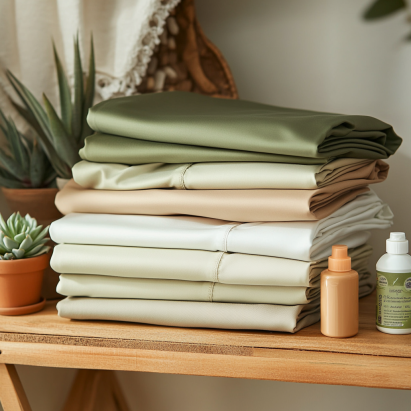Advantages of Eco-Friendly Bedding
The advantages of eco-friendly bedding go far beyond a good night’s sleep. By choosing sustainable, chemical-free materials, you support your health, protect the environment, and encourage ethical manufacturing—all from the comfort of your own bed.
Key Takeaways
- Eco-friendly bedding improves sleep quality and reduces your carbon footprint.
- Made from sustainable materials, it’s free from toxic chemicals and safer for sensitive skin.
- Supporting eco-friendly bedding means choosing ethical practices and protecting natural resources.
- Switching to green bedding creates a healthier home and a more sustainable world.
- The advantages of eco-friendly bedding are wide-ranging—from comfort to conservation.
The Health Benefits of Eco-Friendly Bedding
One of the primary advantages of eco-friendly bedding is its positive impact on your health. These bedding options use organic cotton, bamboo, hemp, or linen—all naturally hypoallergenic and free from harsh chemicals like formaldehyde, flame retardants, and pesticides found in conventional bedding. This reduces the risk of skin irritation, allergies, and respiratory problems, making it a safer choice for everyone, especially those with sensitivities or asthma.
The breathability of natural fibers also supports better temperature regulation, so you stay cool in summer and warm in winter, contributing to more restful sleep. A healthier sleep environment leads to improved overall well-being, reinforcing why the advantages of eco-friendly bedding are worth considering for every household.

Choosing eco-friendly bedding supports both your personal wellness and the environment—an advantage that grows with every restful night.
The Environmental Benefits of Eco-Friendly Bedding
When you think about the advantages of eco-friendly bedding, environmental impact is front and center. Traditional bedding—especially those made from conventional cotton or synthetics—requires large amounts of water, energy, and harmful chemicals to produce. Eco-friendly bedding, on the other hand, uses renewable materials like organic cotton and bamboo, grown using sustainable methods that reduce water use and pollution.
These sustainable practices preserve soil health, encourage biodiversity, and cut down on landfill waste, since eco-friendly bedding is biodegradable and often comes in recyclable packaging. Every step in the production process is designed to minimize environmental harm, so you can sleep soundly knowing your bedding choice helps preserve the planet for future generations.

Explore more about sustainable sleep in eco-friendly bedroom essentials.
Improving Indoor Air Quality
Another often-overlooked advantage of eco-friendly bedding is its role in improving indoor air quality. Synthetic bedding can off-gas volatile organic compounds (VOCs) and other toxins, which linger in your bedroom air and may cause headaches, respiratory issues, and long-term health concerns.
Eco-friendly bedding, made from natural fibers and processed without harsh chemicals, doesn’t emit VOCs or harmful fumes. This creates a cleaner, safer, and more breathable environment—especially important for children, allergy sufferers, and anyone who values a truly fresh bedroom. Cleaner air means deeper sleep and better health.

Want more ways to boost your bedroom air quality? Check out these sleep-friendly houseplants.
Ethical Practices and Conservation Efforts
The advantages of eco-friendly bedding also extend to the people who make it and the communities involved in its production. Many sustainable bedding brands embrace fair trade practices, ensuring fair wages, safe working conditions, and support for local farmers. This approach empowers workers and uplifts communities, making your bedding choice one that’s good for people as well as the planet.
Furthermore, eco-friendly bedding companies are committed to conservation—using low-impact dyes, reducing water and energy usage, and investing in habitat protection. Supporting these brands means participating in a global effort to protect wildlife and preserve natural resources, all while enjoying the everyday luxury of high-quality bedding.

Read more about responsible brands in our guide to organic bedding companies.
Tips for Making the Switch
Transitioning to eco-friendly bedding is easier than ever. Here’s how to maximize the advantages of eco-friendly bedding in your home:
- Look for certifications like GOTS (Global Organic Textile Standard) or OEKO-TEX to ensure genuine sustainability.
- Choose natural fibers such as organic cotton, bamboo, or hemp for the best health and environmental results.
- Wash gently with eco-friendly detergents and line-dry when possible to prolong the life of your bedding and reduce energy use.
- Go beyond sheets—consider organic pillows, mattress toppers, and blankets for a fully sustainable sleep space.
For more tips on sustainable living, see how to build a sustainable bedroom.
FAQ
What are the main advantages of eco-friendly bedding?
How do eco-friendly bedding materials compare to conventional options?
Can eco-friendly bedding really improve sleep quality?
Where can I find trustworthy eco-friendly bedding brands?
Learn more in eco-friendly sleep choices and bedding options,
how sustainable bedding compares to traditional, and
the best organic mattress reviews.
For further reading, see expert resources at Sleep Foundation, EPA Sustainable Materials Management, and Architectural Digest.
Related reading from Cozy Bed Quarters
- Eco-Friendly Sleep Choices and Bedding Options
- Best Organic Bedding Brands
- How to Build a Sustainable Bedroom
Other reading we found popular
- Sleep Foundation – Organic Bedding Guide
- Eachnight – Sustainable Sleep Insights
- Apartment Therapy – Eco-Friendly Bedroom Tips
- Ethical Bedding – Sustainability Resources























